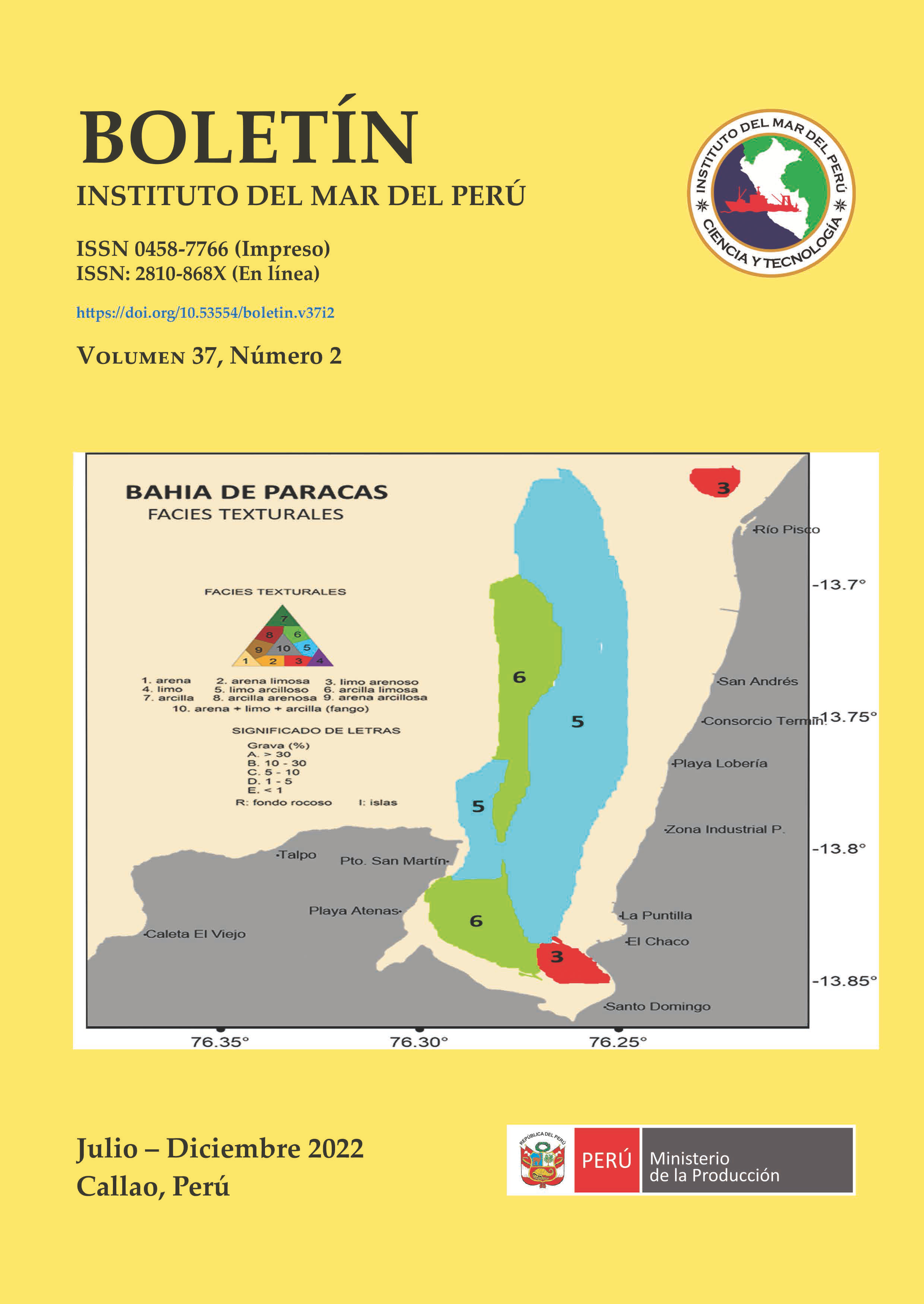Chemical conditions in autumn after the 2017 coastal El Niño during the 2017-0506 Research Cruise for demersal resources
DOI:
https://doi.org/10.53554/boletin.v37i2.376Keywords:
Clorofila, El Niño Costero, Recursos Demersales, Nutrientes, Oxígeno, Condiciones OceanograficasAbstract
Our work presents the results of the distribution of oxygen, chlorophyll-a, and nutrient along the Peruvian coast, obtained in autumn 2017 (May 27 to June 15) within 100 nm. We aimed to evaluate the chemical conditions during the research cruise targeting demersal resources after the occurrence of the 2017 coastal El Niño (cEN). Upwelling cells were found off Talara, Paita, Punta la Negra, in an extensive region between Mórrope and Salaverry and off Chicama, resulting from oxygen contents below 4.0 mL.L-1 within 20 to 40 nm, approximately. Off Puerto Pizarro, the oxygen content exceeded 0.5 mL.L-1 in the water column over 300 m deep, while off Paita, the upper edge of the Oxygen Minimum Zone (< 0.5 mL.L-1) was located below 200 m deep. In the northern zone, these oxygenation conditions would correspond to the remnant effects of the final phase of the 2017 cEN. Regarding Chicama, a shallower OMZ was observed, covering part of the shelf above 50-100 m, with some oxygenation between 20 and 50 nm, while in Chimbote it covered the shelf up to 25 m deep. The chlorophyll-a concentrations, on average, were higher than 2.5 μg.m-3, with one cell off Paita with more than 5.0 μg.m-3, and a maximum value of 23.08 μg.m-3 off Chimbote. The latter was associated with a Nitrogen/Phosphorus (N/P) ratio of 4.81, a non-redfieldlian behavior, due to high nitrate consumption.
Downloads
Alternative Metrics
Metrics
References
Calienes, R., Guillen, O., Lostanau, N. (1985). Variabilidad Espacio – Temporal de Clorofila, Producción Primaria y Nutrientes frente a la Costa Peruana. Bol Inst Mar Perú, 10(1), 1-44.
Carrit, D. E., Carpenter, J. H. (1966). Comparison and evaluation of currently employed modifications of Winkler method for determining dissolved oxygen in seawater—a NASCO report. J. Marine Res., 24, 286–319.
ENFEN. (2017). Informe Técnico Extraordinario N°001- 2017/ENFEN EL NIÑO COSTERO 2017. Julio 2017. http://enfen.gob.pe/download/informe-tecnico-elnino-costero-2017/
ENFEN. (2017). Informe Técnico ENFEN Año 3 N°06. Diagnóstico Climático y Previsión de El NiñoOscilación del Sur en el Perú, junio 2017. http://enfen.gob.pe/download/informe-tecnico-2017-6/
Graco, M., Ledesma, J., Flores, G., Girón, M. (2007). Nutrientes, oxígeno y procesos biogeoquímicos en el sistema de surgencias de la corriente de Humboldt frente a Perú. Rev. peru. biol., 14(1), 117- 128.
Kim, O.-S., Imhoff, J. F., Witzel, K.-P., Junier, P. (2011). Distribution of denitrifying bacterial communities in the stratified water column and sediment–water interface in two freshwater lakes and the Baltic Sea. Aquat. Ecol., 45, 99–112. doi: 10.1007/s10452-010-9335-9337
Knap, A., Michaels, A., Close, A., H. Ducklow, H., Dickson, A. (eds.). (1996). Protocols for the Joint Global Ocean Flux Study (JGOFS) Core Measurements. JGOFS Report, 19, vi+170 pp. Reprint of the IOC Manuals and Guides No. 29, UNESCO 1994.
Redfield, A. C. (1958). The biological control of chemical factors in the environment. Am. Sci., 64, 205–221.
Strickland, J., Parson, T. (1972). Practical Handbook of Seawater Analysis. Fisheries Board of Canada Ottawa, Bulletin 167.
Wittorf, L., Bonilla-Rosso, G., Jones, C. M., Bäckman, O., Hulth, S., Hallin, S. (2016). Habitat partitioning of marine benthic denitrifier communities in response to oxygen availability. Environ. Microbiol. Rep., 8, 486–492. doi: 10.1111/1758-2229.12393
Downloads
Published
How to Cite
Issue
Section
License
Copyright (c) 2022 Boletin Instituto del Mar del Perú

This work is licensed under a Creative Commons Attribution 4.0 International License.










